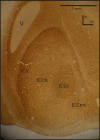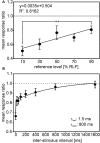The representation of sound localization cues in the barn owl's inferior colliculus
- PMID: 22798945
- PMCID: PMC3394089
- DOI: 10.3389/fncir.2012.00045
The representation of sound localization cues in the barn owl's inferior colliculus
Abstract
The barn owl is a well-known model system for studying auditory processing and sound localization. This article reviews the morphological and functional organization, as well as the role of the underlying microcircuits, of the barn owl's inferior colliculus (IC). We focus on the processing of frequency and interaural time (ITD) and level differences (ILD). We first summarize the morphology of the sub-nuclei belonging to the IC and their differentiation by antero- and retrograde labeling and by staining with various antibodies. We then focus on the response properties of neurons in the three major sub-nuclei of IC [core of the central nucleus of the IC (ICCc), lateral shell of the central nucleus of the IC (ICCls), and the external nucleus of the IC (ICX)]. ICCc projects to ICCls, which in turn sends its information to ICX. The responses of neurons in ICCc are sensitive to changes in ITD but not to changes in ILD. The distribution of ITD sensitivity with frequency in ICCc can only partly be explained by optimal coding. We continue with the tuning properties of ICCls neurons, the first station in the midbrain where the ITD and ILD pathways merge after they have split at the level of the cochlear nucleus. The ICCc and ICCls share similar ITD and frequency tuning. By contrast, ICCls shows sigmoidal ILD tuning which is absent in ICCc. Both ICCc and ICCls project to the forebrain, and ICCls also projects to ICX, where space-specific neurons are found. Space-specific neurons exhibit side peak suppression in ITD tuning, bell-shaped ILD tuning, and are broadly tuned to frequency. These neurons respond only to restricted positions of auditory space and form a map of two-dimensional auditory space. Finally, we briefly review major IC features, including multiplication-like computations, correlates of echo suppression, plasticity, and adaptation.
Keywords: adaptation; auditory; central nucleus of the inferior colliculus; frequency tuning; interaural level difference; interaural time difference; plasticity; sound localization.
Figures









Similar articles
-
An anatomical basis for visual calibration of the auditory space map in the barn owl's midbrain.J Neurosci. 1997 Sep 1;17(17):6820-37. doi: 10.1523/JNEUROSCI.17-17-06820.1997. J Neurosci. 1997. PMID: 9254692 Free PMC article.
-
A site of auditory experience-dependent plasticity in the neural representation of auditory space in the barn owl's inferior colliculus.J Neurosci. 2000 May 1;20(9):3469-86. doi: 10.1523/JNEUROSCI.20-09-03469.2000. J Neurosci. 2000. PMID: 10777810 Free PMC article.
-
Responses of neurons in the auditory pathway of the barn owl to partially correlated binaural signals.J Neurophysiol. 1995 Oct;74(4):1689-700. doi: 10.1152/jn.1995.74.4.1689. J Neurophysiol. 1995. PMID: 8989405
-
The neural coding of auditory space.J Exp Biol. 1989 Sep;146:307-22. doi: 10.1242/jeb.146.1.307. J Exp Biol. 1989. PMID: 2689568 Review.
-
The synthesis and use of the owl's auditory space map.Biol Cybern. 2003 Nov;89(5):378-87. doi: 10.1007/s00422-003-0443-5. Epub 2003 Dec 4. Biol Cybern. 2003. PMID: 14669018 Review.
Cited by
-
Effect of Stimulus-Dependent Spike Timing on Population Coding of Sound Location in the Owl's Auditory Midbrain.eNeuro. 2020 Apr 23;7(2):ENEURO.0244-19.2020. doi: 10.1523/ENEURO.0244-19.2020. Print 2020 Mar/Apr. eNeuro. 2020. PMID: 32188709 Free PMC article.
-
A Metric for Evaluating Neural Input Representation in Supervised Learning Networks.Front Neurosci. 2018 Dec 14;12:913. doi: 10.3389/fnins.2018.00913. eCollection 2018. Front Neurosci. 2018. PMID: 30618549 Free PMC article.
-
Envelope contributions to the representation of interaural time difference in the forebrain of barn owls.J Neurophysiol. 2017 Sep 1;118(3):1871-1887. doi: 10.1152/jn.01166.2015. Epub 2017 Jul 5. J Neurophysiol. 2017. PMID: 28679844 Free PMC article.
-
Spatial cue reliability drives frequency tuning in the barn Owl's midbrain.Elife. 2014 Dec 22;3:e04854. doi: 10.7554/eLife.04854. Elife. 2014. PMID: 25531067 Free PMC article.
-
Hunting increases phosphorylation of calcium/calmodulin-dependent protein kinase type II in adult barn owls.Neural Plast. 2015;2015:819257. doi: 10.1155/2015/819257. Epub 2015 Feb 18. Neural Plast. 2015. PMID: 25789177 Free PMC article.
References
-
- Aitkin L. M., Pettigrew J. D., Calford M. B., Philips S. C., Wise L. Z. (1985). Representation of stimulus azimuth by low-frequency neurons in inferior colliculus of the cat. J. Neurophysiol. 53, 43–59 - PubMed
LinkOut - more resources
Full Text Sources

